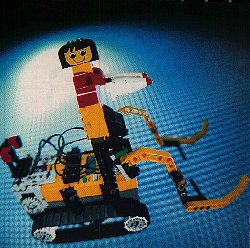
BOYS' TOYS

By Red Symons


By Red Symons
 When the first of my three sons was born, my father wistfully suggested that he had seen some nice-lookmg steam engines in a toyshop. I was taken back 40 years to a living room where he was building a Meccano fairground carousel powered by steam.
When the first of my three sons was born, my father wistfully suggested that he had seen some nice-lookmg steam engines in a toyshop. I was taken back 40 years to a living room where he was building a Meccano fairground carousel powered by steam.Stephen Biddulph, in his SNAG manual, Manhood, correctly observes that our neglected children no longer learn from observing us at work in the fields. What Biddulph may have overlooked is we now teach them by employing the proliferating world of toys. A good toy is not for the children; it's for me to play with and for the children to sit at my lotus feet. Mothers do not always understand this and often feel that time should be spent doing something "useful" like transporting clothes from the bedroom floor to the laundry. My children and I are undaunted by the information age. The only people who can't program a VCR are unimaginative comedians. I have completed The Logical Journey of the Zoombinis and Treasure Math Storm despite the distraction of my children whining over my shoulder that it's their turn. I believe their self-esteem has grown from observing my mastery of first grade arithmetic. This is education by stealth. Give them something to play with that forces their attention in a useful direction - sport for the mind. My only reservation is that I am preparing them for some Orwellian work-cubicle of the next century where they are denied even the physicality of the odd paper clip and elastic band fight. Lego Mindstorms offers an escape. It's the first toy of the computer age that actually does something in the real, material world other than mispronounce the last letter of the alphabet. It's a programmable robotics kit. Lego Mindstorms is a brain, two muscles, rwo pressure nerves, an eye, a voice and a whole bunch of connectable ligaments, and can be expanded to a temperature sensor and a rotation counter. These capacities are minimal. The "eye" is a single-celled light sensor and the muscles are electric motors but anyone who has written assembly language, dissected a frog or understands Turing machines will recognise that complex mechanisms are created by compounding simple ones. The really cute part is the programming language. You join jigsaw pieces of code, "On For...", "Wait", "Reverse Direction" and True/False sensor branches, put them inside iterative loops, and via an infra-red device hanging off a computer communications port chat up the RCX mobile brain and download a sequence of instructions. Students of Theory of Computation (Melb.) in the '60s had to submit punched cards in the late afternoon, to be processed overrnight, to find that they were wrong the next day. I know. I was one and my overnight attention span did not stretch to mainframe operating systems such as Fortran. With Lego Mindstorms you can prove that you are a crap programmer instantly, and then fix it. Quickly. Meanwhile, the children look askance and the wife querulously enquires how long you will be "playing". She may not realise that one could use the light sensor to seek and identify a black sock, use the temperature sensor to assess the degree of composting that had already occurred, and if a condition existed whereby the sock, like an over-ripe haystack, was about to self-combust, then the RCX could opt to pick up the sock and take it to the bathroom. Having a white-carpeted house with a black-tiled bathroom and no heating might be a necessary precondition for optimum operation but I believe that this is a reasonable cost/benefit. It's through play like this that the vacuum cleaner, the refrigerator and the Leyland P76 were born. Ultimately, rather than having an argument about whether the eight-year-old and I were "playing" or "doing somethmg useful" we elected to rise at 5am so we could go about our men's business undisturbed before matron awoke. With two or three of these units we could probably knock together a fairly serviceable woman.
|
LOOK AT OTHER GREAT CYBERLIFE ARTICLES:


 Please mail any comments and suggestions to:
robin_knight@bigfoot.com
Please mail any comments and suggestions to:
robin_knight@bigfoot.com